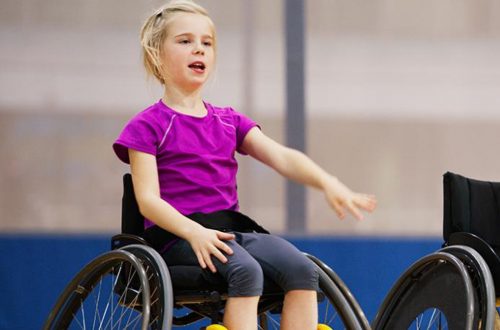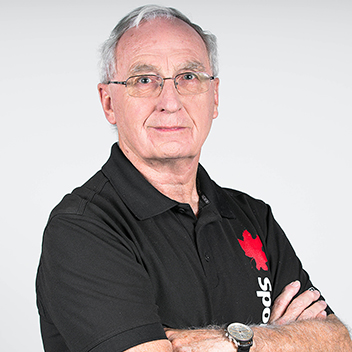Colin Higgs and the relentless infusion of inclusion
C olin Higgs’s life was about to change.
olin Higgs’s life was about to change.
The Memorial University professor was working in his office in 1979 when there came a knock at the door: three world-class athletes were looking for his help. Still in the early years of his career, he was beginning to develop a reputation for his work in biomechanics, sport development, and inclusion. It was for this reason they’d sought him out.
“These athletes were looking for my help because in 1980 they were planning to compete in the Paralympic Games in Holland, and they came to me because they were concerned that most of their competition would be training on the track over the course of the winter. Now in St. John’s, Newfoundland, with the amount of snow you get there, you simply can’t race outside in a wheelchair,” said Higgs.
“They wanted to figure out a way to train indoors, and I knew right away it would be an interesting challenge. My whole career has been about taking on interesting challenges.”
Higgs ultimately came up with an innovative solution from an unlikely source — Sobeys, the grocery store. At the time it had rollers that were used for transporting groceries, and as soon as he saw them he had a eureka moment. After a conversation with the owners he was able to source some to create a contraption that would allow his athletes to train while stationery. No matter how hard they pumped their wheels, they would stay in one place. He attended their practices to see how his handiwork held up.
“Then I saw their equipment they’d been working with, and I recognized there were a lot of improvements that could be made. From there I just kept falling down the rabbit hole.”
That’s how Higgs came to custom-design new racing wheelchairs for the athletes, wheelchairs that would ultimately propel them to multiple gold medals. It was somewhere around this time that Higgs realized he’d found a passion worthy of devoting his life to.
Joining the Sport for Life team
The Canadian Sport for Life (CS4L) movement, which predated the Sport for Life Society by a decade, was in its infancy when Higgs first became aware of it in 2004. It had just expanded beyond its B.C. borders to take on a broader national mandate. He’d been working with highly marginalized youth in such far-flung locations as Sri Lanka and the West Indies, running programs for genocide victims and offering opportunities for those with HIV/Aids. Repeatedly he found himself approached by national sport organizations looking for his expertise.

Dr. Colin Higgs
“I went to this meeting in Ottawa because I’d been doing some work with the federal government, and I guess my name came up. I already knew the founders, Richard Way and Istvan Balyi, and I was interested in looking at improving the system, so I participated in a series of meetings that ended up producing a report about how to advance sport for athletes with disabilities in Canada,” he said.
From there he worked as part of a five-member team along with Way, Balyi, Dr. Stephen Norris, and Charles Cardinal, to create the resource that would establish Canadian Sport for Life within the Canadian sport system: Canadian Sport for Life—Long-Term Athlete Development. And though some felt athletes with disabilities deserved their own standalone document, Higgs felt that they needed to be included in every part of the resource. During meetings at a motel near the Calgary Airport, the group of five had long, meandering conversations about how exactly to accomplish that.
“My key point that transcends everything: I wanted above all else for working with people with disabilities in communities and sport or anywhere to be absolutely normalized. You may have to do something slightly different, but the ultimate program would be one where everything was articulated in such a way that it could be interpreted for people with disabilities, or anyone else.”
He was hooked. Once they completed that task, he set out immediately to produce No Accidental Champions, a resource intended specifically for people with physical disabilities. It laid out a clear pathway to high performance sport, itemizing for sport organizations exactly how to achieve inclusion. Upon its publication he had another realization—they needed to include people with intellectual disabilities as well, resulting in his good friend Dr. Mary Bluechardt joining the team. All of this work was based on his philosophy of creating “the least restrictive environment possible”.
“What that means is you approach every activity with everyone doing the same thing until their impairment prevents them from doing it in the same way, so you make the smallest possible accommodation to let that person continue with the activity. You ask ‘what’s the minimum I can do to ensure that person has the same opportunities?’”
“For example, a kid could be in a wheelchair in school, taking part in everything, but unfortunately the science lab is on the second floor and there’s no elevator. So you could move the lab to the ground floor, you could put in an elevator, or you could carry them up the stairs. I have preferences, obviously, but really the most important thing is they get to science.”
As far as Higgs is concerned, inclusion is non-negotiable.
“You can either articulate that it’s morally right, or you can start from my position which is that it’s a human rights issue. We must always be striving to include everyone.”
Building a lasting legacy
His passion was infectious. The CS4L movement, which incorporated into the Sport for Life Society in 2014, continued to produce resources and introduce innovations into the Canadian system. Way—the movement’s architect and now CEO of Sport for Life—was repeatedly wowed by Higgs’s “relentless infusion of inclusion”. It became an intimately intertwined aspect of the work they were doing, though they were at times met with controversy.
“With No Accidental Champions there was a lot of discussion around that name, and whether or not individuals with disabilities would be offended by that name. It was supposed to communicate that creating champions was a planned process, that you don’t become a champion by mistake. It was about deliberation, the planning and evolution of the athlete, but at the time it was a flash point and there were lines drawn in the sand,” said Higgs.
“But one of the things about Sport for Life in general, and with our work pertaining to people with disabilities, is that it’s logically sound. It stands the test of time, it’s unassailable.”
At one point in his career, Higgs met with a number of athletes to hear their feedback. Growing out of those conversations were two new steps that were ultimately named Awareness and First Involvement. They emphasized the importance of the pre-stages of the pathway.
“What I heard from them was that their first time with sport was super critical. If they showed up and got any sense that the coach didn’t want them there, they would withdraw. People get sucked in or turned away based on how well they’re treated.”
Halfway there
As Higgs looks back on what’s been accomplished during his 16 years with Sport for Life, he’s proudest of how thoroughly normalized his ideas have become. Though he feels there’s a long way to go to properly implement both Long-Term Development in Sport and Physical Activity (formerly Long-Term Athlete Development) and the inclusive practices he’s championing, he has hope that process is well underway.
“Now this is the way that Canadians in the sport system think about sport. It’s the way people expect it to be done. Now we don’t always implement it particularly well, but conceptually this is the way forward. The work has given the predominantly younger and more progressive people in sport the ammunition they need to make the changes they wanted to see anyway. We just give them the framework.”
By his estimation, the sport system has come 50% of the way by achieving culture change and wide acceptance. The other 50% is implementation, which can be tricky depending on what level of the sporting system you’re interacting with — they’ve primarily worked alongside national sport organizations (NSOs) but need to figure out a way to reach the provincial, regional and club level. That gets exponentially harder as the numbers of involved people grows.
“Sure, we can work with national sport organizations and provincial sport organizations, but can we work with 12,000 clubs? That’s our remaining challenge.”
Higgs has continued to author resources alongside Way and his team, most recently releasing the third iteration of Long-Term Development in Sport and Physical Activity (formerly Long-Term Athlete Development). He played a major role in creating the Athlete Development Matrix—a technical guide for NSOs—and was instrumental in the development of physical literacy understanding within Sport for Life. He believes in the Japanese concept of Kaizen, which means continuous improvement, which is why he’s already working on the fourth version of the Long-Term Development resource.
“Lots of people would be happy for us not to develop further, to simply focus on implementation, but if we believe in Kaizen then we need to live it. I’m constantly pushing for change because there’s still that 50% of the process that remains to be done, and that’s where I see myself spending the coming years. I’m constantly asking myself: what’s next?”
